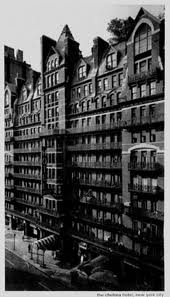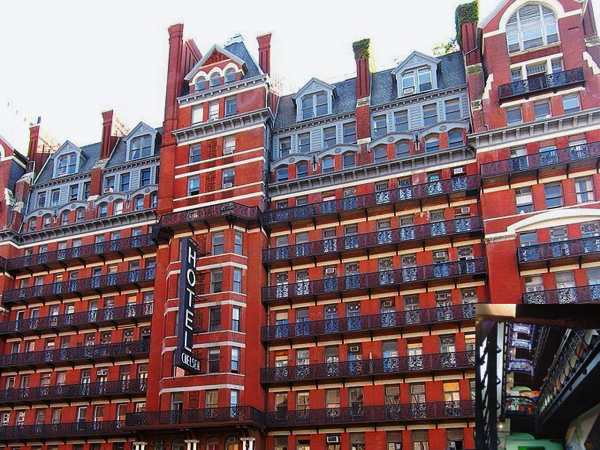A History of Creativity and Tragedy
In the heart of New York City stands the Chelsea Hotel, a place where art and history meet in a hauntingly beautiful way. Built in 1884 on 23rd Street, this 10-story red brick building with its Victorian Gothic design, wrought-iron balconies, and ornate turrets is more than just a piece of architectural history. It has been a haven for artists, musicians, writers, and even refugees, while also playing host to some of the city’s darkest tragedies. The Chelsea’s history is marked by creativity, eccentricity, and a unique blend of vice and virtue that continues to draw visitors and residents alike.
Birth of a Cultural Landmark
The Chelsea Hotel was originally constructed as a cooperative apartment building with 100 units, boasting features ahead of its time—soundproof walls, fireplaces, and unique layouts that made each room distinctive. Its soundproofing and grandeur made it an ideal location in New York’s original theater district, and its opulent Victorian Gothic style only added to its allure. The grand wrought-iron staircase, which remains today, winds through the center of the hotel, a testament to the craftsmanship of the era.
The building transitioned into a hotel in the early 1900s, splitting its original 100 units into 400, with 100 rooms reserved for short-term guests and 300 for long-term residents. Despite this shift, the Chelsea retained its character and became a place for the city’s most creative and countercultural minds to gather.
A Home for Artists and Eccentrics

From its inception, the Chelsea attracted a certain type of resident—individuals drawn to the arts, counterculture, and a bit of rebellion. Over the years, the hotel housed some of the most influential artists, writers, and musicians of the 20th century. The likes of Eugene O’Neill, Thomas Wolfe, Arthur C. Clarke, Janis Joplin, Leonard Cohen, Bob Dylan, and Andy Warhol all spent time within the Chelsea’s walls. Clarke even wrote part of 2001: A Space Odyssey while living at the hotel.
These creative minds were drawn to the Chelsea for its unique energy, a mixture of bohemian freedom and the sense that anything could happen. Stanley Bard, who took over as the landlord in the 1950s, became a part of the artistic community, allowing tenants to pay rent with artwork or simply giving them a break if they were struggling. Many of these art pieces remain in the hotel today, a visual record of its storied past.
Tragedy and Loss at the Chelsea
While the Chelsea Hotel was a haven for creativity, it also became a place of sorrow and tragedy for many of its residents. Perhaps the most famous of these was the poet Dylan Thomas, who died in 1953 after a drinking binge in room 206 that led to alcohol poisoning. His final words—“I’ve had eighteen straight whiskeys, and I think that is a record”—have become legend.
In 1968, Charles R. Jackson, the author of The Lost Weekend, took his own life in his Chelsea room, a tragic end for a man who had struggled with addiction. Charles James, often referred to as America’s first couturier, died in his room in 1978 after living at the Chelsea for 14 years. These deaths are only a few among many that have marked the hotel’s dark history.
One of the most infamous events to take place at the Chelsea happened in 1978 when Sid Vicious, bassist of the Sex Pistols, was living there with his girlfriend, Nancy Spungen. On October 12, Spungen was found stabbed to death in their room. Vicious was arrested but claimed he couldn’t remember whether he had killed her or if someone else had. Before he could stand trial, he died of a heroin overdose. Some speculate that his mother, believing he couldn’t survive jail, provided him with the fatal dose.
Haunted by the Past: Ghosts of the Chelsea Hotel
With such a long history of creativity and tragedy, it’s no surprise that the Chelsea Hotel is rumored to be haunted. Numerous residents and visitors have reported strange occurrences, from cold spots and unexplained noises to full-on apparitions.
One of the most famous ghosts said to haunt the Chelsea is Nancy Spungen herself. After her violent death, some guests claim to have seen her spirit lingering near the room where she died, her presence a reminder of the tragedy that took place.
However, it’s not just Nancy who is said to haunt the halls of the Chelsea. One of the hotel’s longest-standing ghosts is that of Mary, a survivor of the Titanic disaster who came to live at the Chelsea in 1912. Having lost her husband when the ship sank, Mary never recovered from her grief. She hanged herself in her room on the eighth floor, and her spirit has been seen ever since, often standing in front of mirrors, adjusting her appearance. Mary is known as the “vain ghost” because of her preoccupation with her looks, which some say is her way of trying to reclaim some control in the afterlife after losing so much in life.
Visitors have reported seeing Mary’s reflection in the mirror near what is now an archway in the west side of the building, where her apartment once stood. Dressed in early 20th-century clothing with her hair styled in a Gibson updo and a hat with a plume, she gazes into the mirror with an air of disdain for the living, as if they are mere annoyances in her eternal existence.
Chelsea Today: A Living Legacy
The Chelsea Hotel remains a landmark in New York City, a place where history, creativity, and the supernatural all converge. Although the hotel has undergone renovations and changes in ownership over the years, it has retained its unique charm and reputation as a haven for artists and eccentrics. Its corridors are filled with the echoes of the past, both joyful and tragic, and it continues to inspire those who walk through its doors.
While some of the Chelsea’s rooms have been modernized, the essence of the hotel remains intact. Its grand wrought-iron staircase still winds through the building, and the layers of paint on the once gleaming woodwork tell the story of a place that has weathered time and change but never lost its spirit.
Today, the Chelsea Hotel is not just a place to stay—it is an experience. Visitors come not only to admire its architecture but also to connect with the stories and spirits of those who came before. Whether you’re an artist seeking inspiration, a history buff exploring the past, or a ghost hunter hoping for a glimpse of the supernatural, the Chelsea Hotel offers a glimpse into a world where creativity and the paranormal intersect.
In Conclusion, The Chelsea Hotel stands as a living monument to New York’s artistic and cultural history. Its halls have witnessed some of the most groundbreaking works of art, music, and literature, as well as some of the city’s darkest moments. From the tragic deaths of Dylan Thomas and Nancy Spungen to the restless spirit of Mary, the vain ghost, the Chelsea’s legacy is one of both brilliance and sorrow. As long as the hotel stands, its stories—both human and ghostly—will continue to captivate and intrigue those who seek them out.

